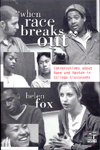It is perhaps appropriate that I finish* this blog with a response to an essay by Paul Carr. Indeed, he has been something of a thorn in my side for over a month now, as co-editor of a book that I have not enjoyed reading, and yet I have never had the chance to address him directly. I cannot tell the reader how many times I have had to suppress the urge to throw The Great White North out the window of Paragraphe bookstore, where I sit and read the chapters each week as an alternative to spending $50 to buy the book. And I am not the kind of person who under-spends on books. But philosophically, The Great White North is just… not my cup of tea.
Still, I have learned a great deal about myself by questioning what it is about the text that bothers me so much. Perhaps it is the heavily theoretical (and overly-emotional) nature of the writing that gnaws at me. As somebody with a background in science, I like to be able to examine the data for myself and draw my own conclusions, and judge whether or not the conclusions of the authors are appropriate. That is to say, I would have valued more emphasis on the history, policy, and current issues in Canada which have a cultural component and which deserve attention from educators and socially active citizens. More than that, I would have preferred to read a book that is more concerned with discussing solutions to problems, rather than one which, in essay after essay, tells me that one exists and that I can’t see it because I’m White. Perhaps I have missed the point, and maybe the fact that I have missed the point proves Carr’s point. Still, I feel compelled to admit here that often, while reading The Great White North, I felt as if I were being preached to, talked down to, or perhaps even indoctrinated.
But enough of that; let’s do something constructive. I was happy that Carr’s essay, The Whiteness of Educational Policymaking, was concerned with policy in Ontario, and I was disappointed that, in his discussion with our class last week, he did not devote more time to talking about policy issues in Ontario. I have sent him an email asking if he’ll answer the open-ended question I composed for him – that is, Is the debate regarding Afrocentric education in Toronto similar to the debate about faith-based education that the province engaged in only a month ago? I am very interested to hear if Carr sees these two issues as nearly identical, or if he judges race-based education and faith-based education as separate debates. His answer to this question, I think, would speak to what he believes multicultural education in Canada should look like.
The questions that Carr poses at the end of his essay are, in the context of my blog, rather redundant. He asks the reader, How should Whiteness be broached within an institutional context by those who may not be in positions of power? He also asks, How should Whites be made aware of, and become engaged in, the conceptualization and application of race and anti-racism? I have already addressed these questions – I think, in nearly every posting, but most specifically here and here. However, there is more than one way to address institutionalized Whiteness, and there is more than one way to make people aware of it. So, I will answer these questions again using a new example, and as a nod to Carr (as if to make up for the rudeness of not enjoying his book), I will take my example from his native Toronto.
 |
is shown here speaking to his class at the Ontario Institute for Studies in Education. Dei says an experimental black-focused school is 'long overdue.' Photo credit: Charla Jones/ Toronto Star |
The Whiteness of Toronto’s public schools has become the target of some scrutiny of late, as the school board, concerned parents and community organizers try to address the high dropout rate among Black students (according to the Toronto Star, the current dropout rate for Black students is “40-something” percent). A solution being deliberated right now is an alternative school specially designed for at-risk Black students, with teachers, mentors, and a curriculum that focus on Black heritage and values. This idea has received a great deal of criticism from the public, with many calling it “segregation” (a one-word sound-bite that is reminiscent of last month’s election). Ontario Premier Dalton McGuinty has said that the idea makes him “personally uncomfortable.”
Now, I’ve disagreed with McGuinty before, and I’m going to disagree with him again. If anything, the 40% dropout rate should make him uncomfortable. Right now, the Toronto District School Board has 33 alternative schools, including ones for gay and lesbian students, and ones for Aboriginal students. If anything, a school for African-Canadian youth at risk seems long overdue. McGuinty’s refusal to entertain ideas of “segregating” students by race or religion is, I think, reminiscent of Charania’s observation that the liberal idea of multiculturalism is having many different students in one environment, regardless of whether or not there is truly social cohesion and peace in that environment. Simply put, wishing that all students of all backgrounds can always learn and live together to the benefit of all does not make it so.
On November 8th and 12th, the TDSB held public meetings to discuss the issue with parents and community leaders. At the first meeting, the general opinion of attendees was in favor of the new school. At the second meeting, the sentiment was more split. Currently, the school board is awaiting a feasibility report, which the prospective staff is expected to file early next year. Below I have embedded reporting on the debate by CityNews:
These public meetings are an example of how I think institutionalized Whiteness can be addressed by people who are not in power. Several hundred people attended in Toronto, which is a promising number that reflects the importance of the issue. It is at these public events, and later in the media which reports on them, that the public can be made aware of the problems that can, and do, arise from the current format of public education. Being educated about racial issues in schools is one thing, but it is particularly meaningful to live those issues and effect their solutions.
While the direct benefits of such a school to the at-risk youth is perhaps obvious, I would also argue that an experiment in Afrocentric education can have positive repercussions throughout the public school community. That is, the curriculum and critical pedagogy developed by teachers and community leaders for the Afrocentric school will be useful to educators in all schools, helping to address directly the problem of White-centered curriculum and teaching in Canada. This is one of the reasons I am such a strong advocate of a diversified field in public education. Open and constructive dialogue among educators from many different schools can, I think, have a synergistic effect on the whole, providing that an open and constructive dialogue is maintained between professionals of all backgrounds. An example of this comes nicely in my response to Charania, which follows below.
The incident described by Gulzar Charania in his essay, A Group That Plays Together Stays Together, is an example of where the perspective of a Black educator would be very useful. Absolutely, addressing a problem such as the one Charania described as a purely class-generated conflict is tantamount to willfully ignoring what is probably the central issue of race. When answering Charania’s question of how the framework of interlocking oppressions reframe issues of girl violence, I am reminded of those two debaters – Napande and Shimby – who noted during their arguments about affirmative action that race and socio-economic status are historically, systemically and unfortunately, intertwined. What was clear to those two girls should have been clear to the administrators of the school Charania studied, and the realization should have indicated that focusing only on economic class to resolve the conflict is as politically cowardly as it is probably ineffective.
A more critical analysis of the conflict between the two groups of girls would have alerted the administrators that there was an element of racial conflict that needed to be addressed. A responsible educator then would have looked for outside expertise to give recommendations on how to proceed, both in addressing the specific students implicated in the incidents and, more broadly, the school as a whole. While the idea to place the students together in a close environment and engage them in activities together was probably born from the best of intentions, I agree with Charania that a better approach would have been to speak to the groups individually before initiating a dialogue. Anti-racist curricular and pedagogical interventions developed by leaders in the Black community, and (perhaps ideally) educators from an Afrocentric school working in conjunction with educators from the predominantly White district would be an effective tool for teachers hoping to educate their students about racism in Canada. Specific examples of the kinds of activities which would be effective in educating students about these issues can be found in my response to Helen Fox.
*To the Teaching Assistant: I have decided that this post will be my last formal response to a homework assignment – the amount of time that I invest in my responses precludes me from answering the questions for the Quintero text before the deadline, though I may post a comment on these readings on a later date.













3 comments:
Thank you for the excellent "presentation" you have put together on what I consider to be part of the broader issue of School Choice in Ontario.
What needs to be addressed is why Ontario, one of our wealthier provinces, is unwilling to provide for school choices in only some areas. Ontario fully funds 675,000 students in Roman Catholic Schools which is one third of our student body. Only the elementary level is guaranteed funding in our Constitution yet high schools continue to be fully funded. Within the Roman Catholic boards exist 5 Ukrainian schools which focus on Ukrainian language, heritage and the Eastern Rite branch of Catholicism (also called Byzantine). Eastern Rite closely resembles Greek Orthodox, Armenian Orthodox and Coptic Orthodox whose schools are not funded. Why? Because 50 years ago the Eastern Rite's decided to make the Roman Catholic Vatican their religious authority! I would agree with the Ukrainian students attending RC schools, but funding for their own schools and culture is wrong if all other religions and cultures are shut out.
As you mentioned, we fund a Gay/Lesbian/Transgender high school in Toronto, French and French Immersion schools, two Native schools, mulitiple Arts (Catholic and Public) as well as Sports-based schools. In addition, their are at least two fully funded Christian schools which Education Minister Wynne refers to as "anomalies" - where do I apply for "anomaly" funding for my kids' Jewish Day School?!
Quebec, Manitoba, Saskatchewan, Alberta and BC provide significant funding (not full) for faith-based schools. Quebec and Alberta promote all manners of school choice by funding any type of school that follow these provinces guidelines. By providing approximately 60% funding for all non-public schools, Quebec is SAVING 40% while still recognizing that as long as the curriculum is followed these students should receive assistance.
So what's the problem in Ontario?! The way I see it we have a monstrous public school system with powerful teacher lobby groups. The teacher lobbies are terrified of school choice because ifthe public school have competition they are forced to raise the quality bar. There also seems to be some fear that some teacher jobs would move from public schools to independent schools. There is no reason why independent school jobs should not be equitable in salary, benefits and unions to the public school positions if the independent schools were funded. The best schools have been found to have a common focus which fosters staff, student and parent involvement.
Reminder: no one is talking about funding "private/elite" schools. This discussion should focus on school choice and what is the best learning enviroment for each child - Arts, Sports, French, Native, Black and even Faith-based Schools.
to Gila, the mysterious stranger:
Thank you so much for the long comment. I wish only that you had included some more information about yourself. I'm pleased that someone outside the domain of this university course has been reading the blog.
I cannot speak to the influence of the Ontario teachers' lobby groups, because I don't know enough about the politics of it to say anything intelligent. What I will do is refer you to my blog on faith-based education in Ontario (Oct.8), and tell you that I plan to continue writing on this and other related issues on a new blog as soon as I have time to set one up (the address is: http://screamingintotheether.blogspot.com/). On the new blog, I will be more at liberty to examine the issues in depth, and perhaps be a little more shrill with my opinions. Stay tuned.
The issue of choice will become a bigger issue in Quebec when Bill 95 comes into effect in 2008, removing religion from public schools across the province. Most likely there will be a great deal of media coverage here about 95, but it will be examined through the lens of identity politics in Quebec.
Which is always fun.
All the best to you,
Kristen.
Post a Comment